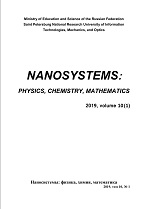|
PHYSICS
Q-switched and mode-locked pulse generations with Ti$_3$AlC$_2$ absorber
Syed Ziad Z. Aljunida, Nurul Athirah M. A. Ghafara, Bilal A. Ahmadb, Retna Apsaric, Sulaiman W. Harunac
a Department of Electrical Engineering, Faculty of Engineering, University of Malaya, Kuala Lumpur 50603, Malaysia
b Department of Communication Engineering, Al-Ma’moon University College, Al-Washash, 700921 Baghdad, Iraq
c Department of Physics, Faculty of Science and Technology, Airlangga University, Surabaya 60115 Indonesia
Abstract:
Exploring advanced saturable absorber (SA) materials that exhibit exceptional performance for achieving Q-switching and mode-locking operations remains a vibrant area of research in the field of fiber lasers. The remarkable optical nonlinearity, coupled with high thermal and chemical stability of MAX phase materials, positions them as promising candidates for high-performance SAs. In this study, we demonstrated the potential of Ti$_3$AlC$_2$ MAX phase as an effective material for Q-switched and mode-locked fiber laser applications. The Ti$_3$AlC$_2$ film was synthesized through a straightforward and cost-effective casting method employing polyvinyl alcohol (PVA) as a host material. The SA was cleverly constructed from the film, utilizing a sandwichstructured fiber-ferrule platform, and seamlessly integrated into an Erbium-doped fiber laser (EDFL) ring cavity. Initially, a stable Q-switched laser was realized at a center wavelength of 1531 nm. The repetition rate exhibited a commendable increase from 35.0 to 50.8 kHz, and the pulse width reduced from 6.58 to 3.40 $\mu$s as the pump power was adjusted within the range of 25.98 to 58.29 mW. Notably, the maximum output power of 2.49 mW and a pulse energy of 49.02 nJ were recorded at a pump power of 58.29 mW. Subsequently, an additional 200 m long single-mode fiber was added into a similar laser cavity, leading to the generation of a stable modelocked laser at a threshold pump power of 81.37 mW, operating at a central wavelength of 1558.96 nm. The observed stable repetition rate of 969.3 kHz, coupled with a pulse duration of 300 ns, demonstrated robust performance as the pump power increased from 81.37 to 113.68 mW. These findings highlight the exceptional performance of Ti$_3$AlC$_2$ SA for both Q-switching and mode-locking applications. The versatility of these lasers makes them valuable for diverse applications, including micromachining of materials, frequency comb generation, and remote sensing.
Keywords:
Ti$_3$AlC$_2$, max phase material, Q-switching, mode-locking, saturable absorber, erbium-doped fiber laser.
Received: 06.01.2024
Revised: 25.03.2024
Accepted: 26.03.2024
Citation:
Syed Ziad Z. Aljunid, Nurul Athirah M. A. Ghafar, Bilal A. Ahmad, Retna Apsari, Sulaiman W. Harun, “Q-switched and mode-locked pulse generations with Ti$_3$AlC$_2$ absorber”, Nanosystems: Physics, Chemistry, Mathematics, 15:2 (2024), 184–191
Linking options:
https://www.mathnet.ru/eng/nano1260 https://www.mathnet.ru/eng/nano/v15/i2/p184
|

| Statistics & downloads: |
| Abstract page: | 54 | | Full-text PDF : | 21 |
|




 Contact us:
Contact us: Terms of Use
Terms of Use
 Registration to the website
Registration to the website Logotypes
Logotypes








 Citation in format
Citation in format 